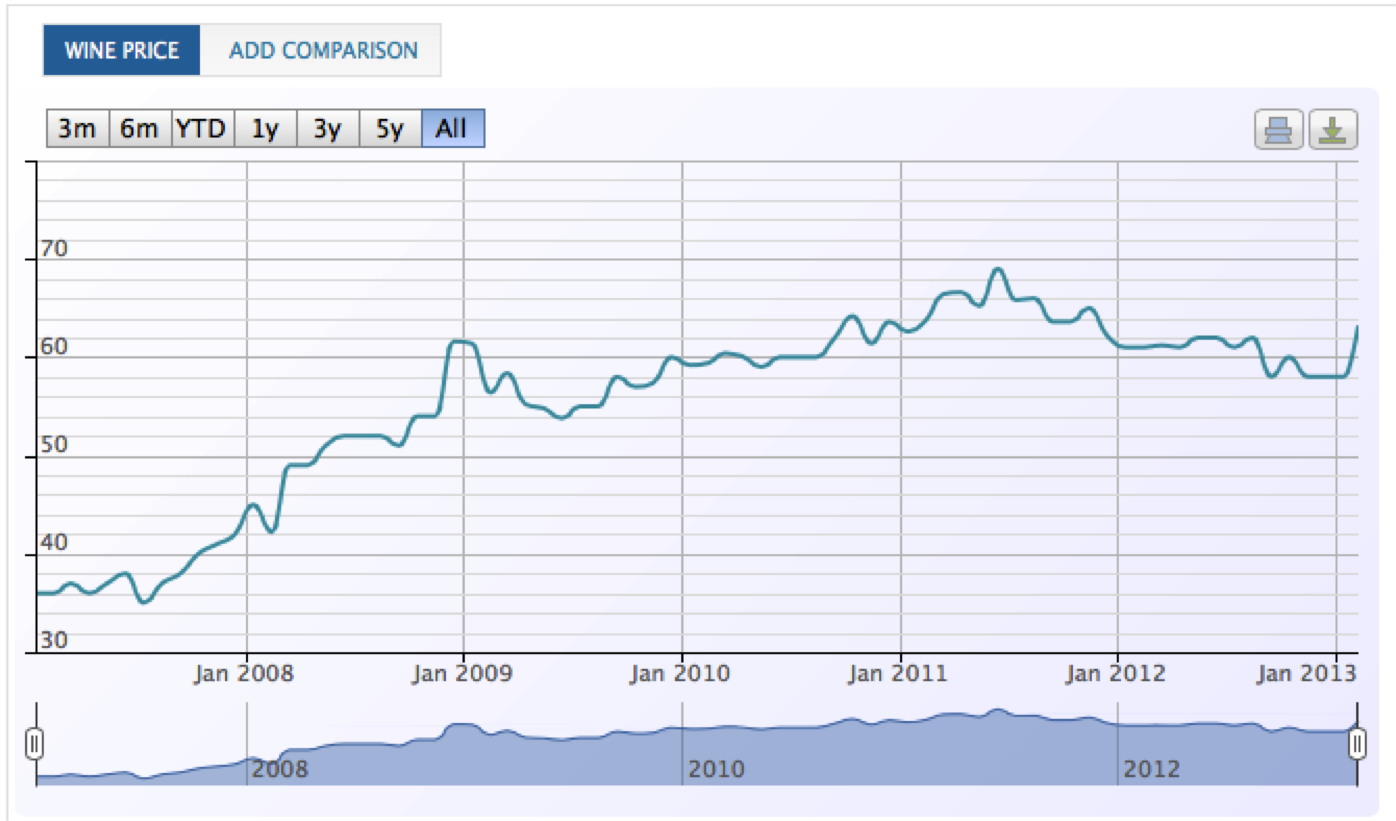by Wine Owners
Posted on 2016-12-14
Two pieces of news caught my attention in December.
The first was Martin Brown, CEO of Wine-Searcher, speaking at a conference in California, noting that increased pricing transparency had not caused market prices of wine to fall.
He wasn’t referring to just fine wine or collectible wine, but rather the effect of his price comparison site on retail prices and the wine market as a whole. I’m paraphrasing, and you can read the whole of the discussion on their blog.
The second was the news that Stanley Gibbons, the stamp specialist and now owner of a group encompassing antiques specialist Malletts and auctioneer Drewetts, has seen it share price tank over the last year (see chart).
Let’s begin with Stanley Gibbons and the stamp market.
STANLEY GIBBONS GROUP PLC ORD 1P
The share price tanked in part because of how it reported revenues from the sale of ‘plans’ in investment grade stamps.
Like fine wine, stamps are a collectible. Unlike fine wine, there is a great deal less price transparency in the stamp market.
As a consequence, Stanley Gibbons used to offer collectible stamp buyers a buy back scheme, whereby the company itself guaranteed the purchaser 75% of their original investment back if the value of the stamps purchased through their Capital Protected Growth Plan fell over a 5-10 year period.
Since the repurchase scheme booked stamps onto their balance sheet at a discounted rate to their own retail catalogue rather than at cost, its auditor has estimated the potential balance sheet liability (and asset write-downs) to be £64M.
Collectible markets are relatively illiquid, in large part because the things that people collect are rarely fungible*.
But just because a market isn’t fungible or liquid doesn’t mean it can’t benefit from price and market transparency. Not to mention direct market access.
The nature of a trading collectible market, as the Stanley Gibbons example highlights, is that very rare examples are quite hard to estimate, whilst more liquid collectibles will tend to sell within or just below the lowest cluster of available market offers for sale.
Onto Martin Brown’s speech on price transparency
Wine-Searcher has done a great job of price comparison and substantially improving price transparency, so that no matter where in the world you are, it’s easy to get a price for and find the wine you want.
The key point is that price transparency has not driven down retail wine pricing, contrary to economic theory, but it has substantially reduced price outliers, both high and low.
Actionable data
Wine Owners works with Wine-Searcher, receiving tens of millions of price point as the building blocks of our Market Level price – the price at which it’s likely a wine will find ready buyers (or the approximate point of market liquidity). That data is combined with traded wine prices and for the rarest wines in the world we’ll be cross-referencing with auction data from the biggest Houses.
Blue chip fine wine behaves like collectible markets, not like CPG markets. Production and therefore supply is limited. Where there is no demand prices fall or stagnate, but where there is a ready market of buyers, prices rise. Just as you’d expect.
In fact, price discovery is the underpinning of all successful and proper-functioning trading markets.
Reliable, actionable pricing data supports buy and sell decisions. It informs counter parties. It breeds confidence, and confidence boosts sentiment.
Direct market access
Combine market transparency based on realistic selling prices with direct market access that allows all market participants to buy and sell on a peer-to-peer basis, and the effect is entirely beneficial. Consumers get the opportunity to sell through their wines across the entire spectrum from interesting drinking bottles to desirable blue chips. Buyers can buy the wines they love to drink or to accumulate as a store of value from fellow wine lovers and collectors with little added market friction due to modest commissions. Counter parties’ confidence to trade is assisted by price transparency and all the settlement and logistics support we offer through the platform.
- - - - - - - - -
* The word fungible is used in relation to a category of asset that is indivisible from each other. Pure gold and shocks and shares are indivisible. One of each is the exactly the same as the next. Collectibles are not fungible. In wine the things that make a difference are storage, fill levels, the condition of labels, capsules, and where the wine has been (wine that’s made the journey from Bordeaux to London to Hong Kong and back again doesn’t give buyers the same quality of juice as Bordeaux to Octavian for example).
by Wine Owners
Posted on 2013-02-17
We're being asked increasingly how Wine Owners arrives at its Market Level pricing, helping to provide a benchmark for real-world valuation of wine collections for its private client users.
So here's how we process millions of data points to give our users pricing insight on their fine wine collections that they can translate into estimates of realisable current market value, less sales commissions.
The source of data comes from WineSearcher, the world's pre-eminent search engine for fine wine, helping wine enthusiasts everywhere to source wines they wish to buy from retailers.
Retail pricing is collected from over 34,000 wine merchants and traders around the world, and this data can be analysed by country and region.

WineSearcher's scope of work is huge, processing millions of data points on wines that are for sale or just sold every day.
How does Wine Owners work with this primary data source?
Our proprietary algorithms process this data to eliminate the inevitable anomalies that such large data sets present. We focus on pricing for the world's top 250,000 fine wines.
For our private client members who appreciate, collect and invest in the fine wine top end of the market, our focus on a specific strata of fine wine pricing enables us to structure, standardise, format, analyse and process these wines in great depth.
How does Wine Owners calculate the Market Level?
We first exclude possible outliers from the source data.
Next we recognise the different liquidity characteristics of the fine wine market and assign a liquisity score to each wine in our database.
Rare wines, old vintages and other wines with limited liquidity are treated differently to incoming streams for top Bordeaux where there is substantial relative market availability and demand.
We then analyse the spread between market low and mid point for each wine and calculate the point between the two, depending on liquidity scores, that constitutes the Market Level.
Our proprietary algorithms are designed to give you the most consistent approach to pricing a market in wine.
Of course, wine is a collectable asset very unlike stocks and shares or gold, and therefore market prices reflect differences in geographical availability and tax status, not to mention condition and history (the essential elements of 'provenance'. What that means is that pricing fine wine is not a wholly scientific process, and a consistent approach such as ours will not capture every market discontinuity. Nevertheless Wine Owners offers users a rigorous approach to calculating Market Level pricing, being a likely pricing level at which your wines can sell without undue delay.
The following price graph, a new version of the existing functionality on https://www.wineowners.com , illustrates the pricing information and interactive site tools you can use to manage your wine collection.

We value based on the market retail value, and therefore you can expect to deduct selling commissions from this price.
by Wine Owners
Posted on 2013-01-07

We're absolutely delighted to welcome Jonathan Picchi to the team!
Jonathan takes on responsibility for our market-leading referential database of fine wine, with a long-term development brief on the top of current processing.
A french national, Jonathan has recently moved to London from his native Paris, having completed a masters in statistics and information analysis from the highly regarded ENSAI school in Rennes.
His expertise in data modelling will be invaluable as we deepen our analysis and interpretation of market data to help fine wine collectors understand the true value of their collections.
Jonathan is pictured in our Old Street offices in London's Shoreditch, EC1.

